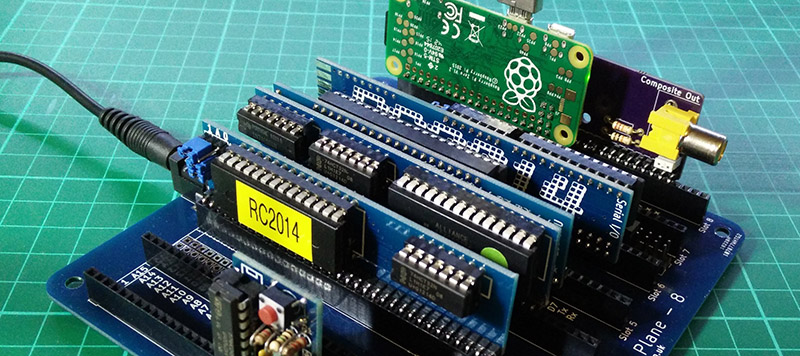While not very popular, building a homebrew computer can be a fun and rewarding process. Most of the time, though, the video capabilities of these computers is as bare bones as it can get – running headless, connected to a terminal. While this is an accurate reproduction of the homebrew computers of the 1970s and 80s, there’s a lot to be said about a DIY computer with an HDMI-out port.
[spencer] built a Z-80-based homebrew computer a few years ago, and while connecting it to a terminal was sufficient, it was a build that could use a little more pizzazz. How did he manage to stuff a terminal in a tiny project box? With everyone’s favorite five dollar computer, the Raspberry Pi Zero.
The computer [spencer] built already had serial inputs, outputs, power, and ground rails – basically, a serial port. The Raspberry Pi also has TX and RX pins available on the 40-pin header, and with a stupidly simple board that [spencer] whipped up in KiCad, he could plug a Pi into the backplane of his homebrew computer. A few setup scripts, and a few seconds after turning this computer on [spencer] could mash a keyboard and wail away on some old school BASIC.
This isn’t a use case that is the sole domain of the Pi Zero. A Parallax Propeller chip makes for a great video terminal with inputs for PS/2 keyboards and mice. A largish AVR, with the requisite NTSC video library, also makes for a great video interface for a homebrew computer. The Pi Zero is only five dollars, though.

The Raspberry Pi Zero contest is presented by Hackaday and Adafruit. Prizes include Raspberry Pi Zeros from Adafruit and gift cards to The Hackaday Store!
See All the Entries
















That really is kinda funny, using such a powerful beastie just to look at a simple system, but a good us for the Zero non the less..
I just wish the PiZeros were available as I have some projects in mind.
Years ago I made a memory mapped video display for my Signetics 2650 system, Originally it ran a 110 baud serial terminal. (My regret is I gave it all away.) The video board was made on Veroboard and I wrote it all in assembler, actually inputting the hex codes via the serial terminal. Those were the days. 11K (not M) of RAM made up of 88 ICs!
If you love it.. Set it free. Surely it was exciting to let someone else use such a personal, custom device!
Just an added note, I think the chips I used were a 68047 video controller and a 6116 RAM.
I used the 6847 ( i beleave it was the same one as the trs 80 color computer) with a z80 cpu.
I wire rapped the hole thing and had 16k of ram. I just came across the ram board the other month.
those were the days.
Yes, it was the 6847 in the Radio Shack Color Computer (until the CoCo III, when the used a custom IC that gave 80 x 24 video among other things). The original CoCo was very much like the “sample circuit” in a Motorola application note for the 6809.
Michael
While at it, can use the Pi for network & disk i/o too.
That’s great and all, but the pi zero is SOLD OUT and has been for over a month.
Makes a whole lot of sense to follow along using an unavailable product.
Maybe you’re just looking in the wrong stores. Whole bucket of Pi at some stores. https://pbs.twimg.com/media/CdYXJQpWEAAFBAO.jpg
Tbh that pic is about as useful as a similar tray at the factory.
This project is as perverse as putting a Merlin V12 in a 55 Chevy.
https://www.youtube.com/watch?v=SIj2GVfua84
Yet Merlin V12’s are easier to get than Raspberry Pi Zero’s!
So if it is displayed on a Raspberry Pi, does it become a “$5 highly misleading headline”?
No, all the processing is done as it was before. The Pi is a $5 video card. How is the headline misleading? When you buy a Nvidia card do you calculate the cost of the motherboard as well?
It’s as much a video card as your computer is when you open a telnet session.
You can’t buy pizero for $5. That’s how.
No, not what I was getting at. Just because the whole shebang puts out a video signal in the end doesn’t mean it is a video card. A car is not a $10000 set of wheels for shoes, an OpenWrt router is not a $10 network adapter for an Arduino, and a Pi Zero is not a $5 graphics card for another computer it is attached to as a terminal. That’s ass backwards and misleading wording, if not downright clickbait.
It’s a really cool project, but I wouldn’t call it a graphics card. I’d call it a dumb terminal.
Agreed ….could of used something appropriate to the age of the parts of the project…might of well used an emulator :9
Overkill and worse based on a product that is unobtainable.
I’d go with Grant Searle’s approach of using a el-cheapo FPGA board to do the entire retro system.
http://searle.hostei.com/grant/Multicomp/index.html
If you don’t want that use Geoff’s Maximite Terminal
http://geoffg.net/terminal.html
I went with the cheapest ARM chip – 48MHz STM32F030F4 16K FLASH 4K RAM for my VGA text terminal project. https://hackaday.io/project/9992-low-cost-stm32f0-based-vga-terminal
The ARM chip is $0.44 a piece (QTY 10) from Aliexpress.
Indeed..even one of those ST based Arduino is only 3$ on ‘bay so you could of done VGA on that..more fun than a Zero
The real story here is the microusbotg adapter he is using, it appears to be this abomination http://www.alibaba.com/product-detail/Nano-micro-USB-OTG-Adapter-for_60197141816.html?spm=a2700.7724857.29.46.A994R7
If a microusb to ‘slides inside of a usb-A’ is not a hack I don’t know what is. Does anyone know where to get one cheaply in the states?
I love it that the supplier you linked to listed flower pots as one of the items it manufactures.
$0.48 with free shipping to the US:
http://www.aliexpress.com/item/Micro-USB-to-Anroid-Phone-Tablet-PC-OTG-Adapter-Converter-USB-adapter-for-Samsung-HTC-Oneplus/32580159272.html
Are you kidding me that adapter is sweet
Untill you plu it into a usbA cable upside down
scambay has them
http://www.ebay.com/itm/2pcs-Micro-USB-Male-to-USB-Female-OTG-Adapter-Converter-For-Android-Tablets-A-/391387431076
2 for a dollar, bought a set for a laugh
IT IS NOT AVAILABLE FOR $5!
YES IT IS!
Adafruit has them for $5. Shipping is a separate product with it’s own costs, but the Pi itself is $5. I’ve gotten two from them.
I believe Micro Center also charges $5, but being in Canada I’ve never even seen a Micro Center so I can’t verify that.
Ok people, I think there’s a bit too much hating going on. I don’t think a hack should necessarily be affordable nor the parts readily available. The guy built something himself, great. I do hope he’s going to upload his code to hackaday.io though, because right now I have no idea how he did it and how difficult it is.
So he’s using a computer far more powerful than the computer it’s plugged into, just for the Pi’s video output capability.
Sure. Makes perfect sense. Like using a chainsaw to cut weeds makes sense.
If the chainsaw is less expensive than the alternative IT MAKES SENSE!
Really people…
Actually no. Its about using the right tool for the right job. Just because something is cheap(but almost unobtainable) doesn’t make it a good hack.
I’d have been more impressed if the hacker went old school and took a Yamaha V9938 or similar beast and used it.
That sure sounds like my PC with it’s crazy NVidia card.
Nice hack sir. :)
Finally, a backplane arrangement! That’s how cheap computers should be made: want more speed? Change the update processor board, want more i/o lines? Just plug in a different i2c/spi/whatever decoder. Want nothing? (ie, Zero?) keep it as is. Too bad the Zero is and will remain unobtanium for a looong time.
This guy made a nice little computer yet the article (and to be honest most of his write up ) is about how he plugged a PI into his serial port. if he had made it into some gadget class VGA device I would of been impressed but this is just gratuitous Pi mentioning …lets see the rest of the project and less of the Pi thankyou !
I want that backplane, what is the manufacturer/model? do you have a link to look for backplanes?
Thanks!